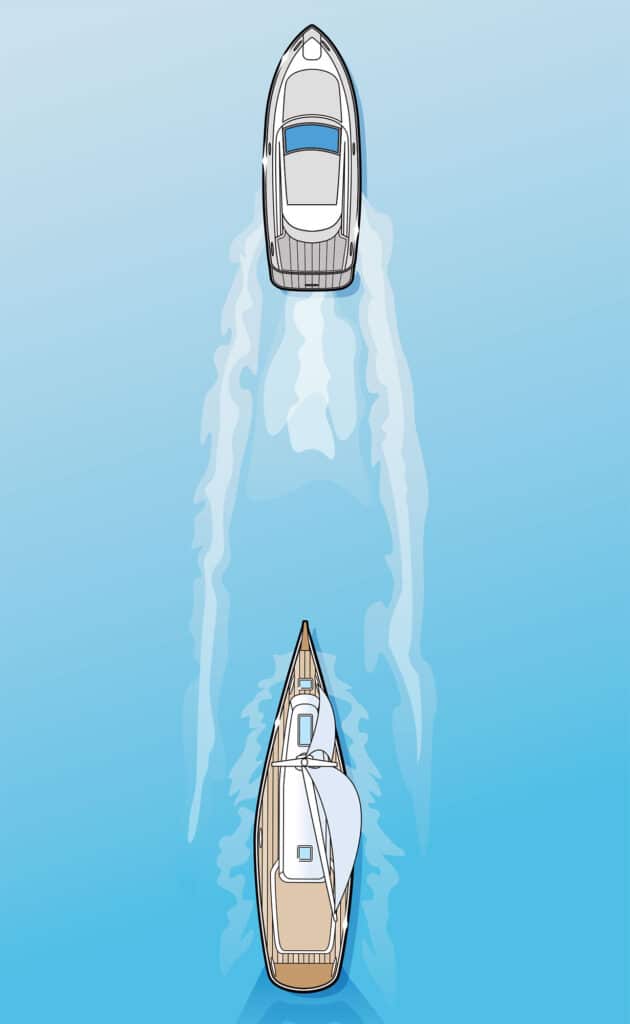
I’m strictly a powerboater and proud of it. But I also respect the skill of sailboaters and was schooled from my earliest days afloat that sailboats are generally assigned the privilege of being the stand-on vessels under the rules of the road because they are restricted in their ability to maneuver.
That means powerboats are the give-way vessels.
An important note: A sailboat must be under sail to qualify as such under the rules of the road. If a sailboat uses its auxiliary motor instead of sails for propulsion, then it must abide by the same rules of the road that apply to powerboats.
Despite my mentoring to recognize the privileges of sailboats, there is one exception in which a powerboat enjoys the status of being the stand-on vessel over a sailboat. Before we go there, let’s review the rules of the road when it comes to scenarios involving power–versus-sail encounters.
Meeting Head-On
In powerboat-versus-powerboat head-on encounters, the best option is for each vessel to maneuver to starboard to allow the boats to pass safely port to port. The same applies when a powerboat encounters a sailboat traveling downwind on a straight course. But things get complicated when sailboats tack upwind on a zigzag course. In open water, sailboats have plenty of room to tack. But within the confines of a channel, a sailing vessel might be forced to come about frequently in short tacks to stay inside the channel.
In this case, the skipper of a powerboat (the give-way vessel) must provide the sailboat (the stand-on vessel) a wide berth to maneuver safely. Within a narrow channel, this might require that a powerboat slows to a dead idle or comes to a halt to give the sailboat the road on your side of the channel and allow it to cross safely well in front of you before it comes about and tacks toward the far side of the channel. Once this occurs, you might well have enough space and time to continue safely at the posted speed limit.
Paths That Cross
When it comes to crossing situations that might pose a collision threat, the rule is pretty simple: The powerboat is the give-way vessel and obliged to pass astern of the sailboat, no matter what direction either boat is traveling.
Overtaking
This is where the exception to the rule comes into play. In overtaking situations, the boat that is overtaking another boat is the give-way vessel, regardless of whether it is a sailboat or a powerboat.
The vessel that is being overtaken is always the stand-on vessel and should maintain its course and speed, while the vessel that’s passing (the give-way vessel) signals its intention with one short blast of the horn if passing to starboard of the stand-on vessel, and two blasts if passing to port of the stand-on vessel. Passing should be undertaken in a safe manner and provide the stand-on vessel with the widest berth possible.
So, there you have it—the exception to the rule when it comes to powerboats versus sailboats. But that leads me to another observation: The same passing procedures apply in overtaking situations between powerboats and human-powered vessels, such as canoes, kayaks, stand-up paddleboards and the like. But how often does a paddler have the opportunity to pass a powerboat or sailboat?
It can happen. It happened to me while idling out of California’s Alamitos Bay. My boat was struck from behind by a single sculler while he sprinted along during his morning workout. Scullers face aft while rowing, so they are blind to the waters ahead. I had my eyes forward and failed to glance astern, so neither of us saw each other. What’s more, sculls travel almost silently at speeds up to 13 mph, and today’s outboards are extremely quiet at no-wake speeds of 5 mph, so neither of us could hear each other. While the encounter proved startling, we suffered no injuries or property damage. After exchanging a few words, we continued on our way.
While the rules of the road favored me as the stand-on vessel, it is also important to point out the most critical rule of all: Avoid a collision, no matter what the scenario. In this case, by glancing astern regularly, I could have spotted the potential for a rear-end collision and given the sculler a wide berth. It is a lesson I learned well and have applied ever since that day.









